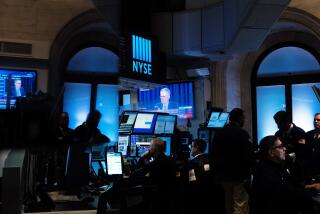Whether to Wrap Oneself Up in Wrap Account
- Share via
Wrap accounts--investment package deals that provide sophisticated investment advice, portfolio performance reports and trading services--are changing the way Americans invest.
These plans, which were introduced only a few years ago, are now one of the fastest-growing segments of the investment industry. Merrill Lynch had only $200 million in wrap account assets at the end of 1988. The brokerage now boasts $4.2 billion. Shearson Lehman Bros. says investors are pouring roughly $200 million a month into their wrap program, which has about $10 billion in assets.
And new plans that allow smaller investors to enter the market are sure to spur even greater growth.
Until recently, wrap accounts were usually available only to those with $100,000 or more to invest. But last week, Shearson introduced a new product called Trak that is based on the same principles but available to those with as little as $10,000 to $25,000.
The allure of these programs comes from what they do and what they deter.
What they do is provide investors with a financial plan, the ability to closely monitor their investments and a personal investment specialist who buys and sells securities based on that one investor’s financial goals.
Usually, when a customer buys a wrap, he or she must sit down with a financial consultant and map out a formal investment plan that delineates goals and the willingness to take risks. The adviser will then suggest choices among a number of investment managers, who have been screened by the brokerage.
The brokerage will track the performance of these accounts and investment managers quarterly to make sure the managers are performing and that their strategies continue to mesh with the investor’s needs. It’s the type of service that was once reserved only for large institutional clients.
What these accounts deter is churning, an illegal practice in which a broker buys and sells a client’s securities solely to generate trading commissions. Reputable brokers don’t churn accounts. But because most brokers earn the bulk of their income through sales commissions, there is an apparent conflict of interest when customers are best served by simply holding on to their shares.
However, wrap accounts are sold on the basis of a single annual fee, which usually amounts to about 3% of the account value. No fees are levied for trades, so the broker gains nothing by churning.
“Clients like it because it puts their financial consultant on the same side of the desk as their accountant or their lawyer--looking out for the client’s best interest,” said Leonard Reinhart, president of Shearson Lehman Bros.’ consulting services division.
Who should invest in a wrap?
Those who wish to actively manage their money--trading in and out of securities frequently--but who lack the time or the expertise to monitor the markets as a professional does.
But they are not for everybody. Investors who have the time, savvy and inclination to investigate and monitor their portfolios can probably do it cheaper themselves than through a wrap account.
Those whose financial strategies cause them to hold on to investments for long periods--trading securities only a few times a year--would also probably be foolish to invest in a wrap. And, if you are not interested in all the services that a wrap account provides, you would probably do better elsewhere. Additionally, if you have an unusually good securities broker, he or she may be able to provide the services available through a wrap account at a far lower cost.
Indeed, Shearson recently conducted an in-house study looking at whether wrap plans made sense for those with relatively large accounts. The study centered on accounts totaling $200,000 and broke them into three categories: heavily traded, infrequently traded and average activity accounts.
Those with heavy trading activity would clearly benefit from a wrap, the Shearson study concluded. But the benefits for the other two groups were not as apparent.
Specifically, the high turnover group bought and sold shares an average of 159 times, which cost them $13,662.87 in retail brokerage fees in 1990--an amount equal to 6.83% of their account value. The low turnover group traded only 18 securities during the year at a total cost of $2,226.60. That amounted to just 1.11% of the account value. Meanwhile, the average group traded 35 times, and their total transaction fees amounted to 3.13% of their account value, or an average of $6,252.75.
Those who fell into the frequent trader group would save by investing in a wrap because their total fees would amount to 3%, versus the 6.83% they paid in commissions. But those with scant account activity should consider whether the additional services that a wrap provides are worth the cost.
More to Read
Inside the business of entertainment
The Wide Shot brings you news, analysis and insights on everything from streaming wars to production — and what it all means for the future.
You may occasionally receive promotional content from the Los Angeles Times.










